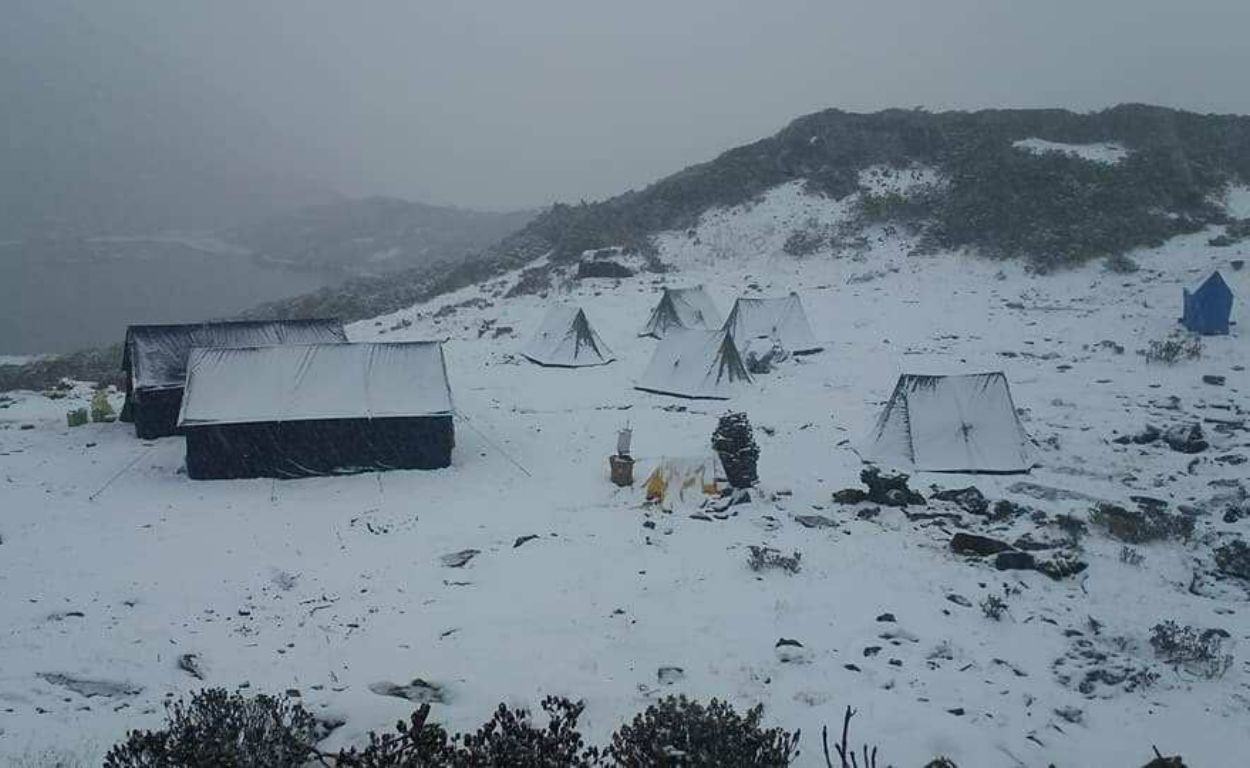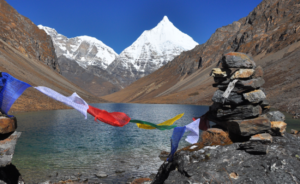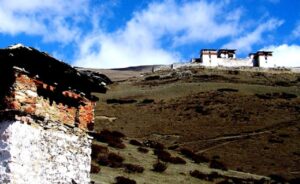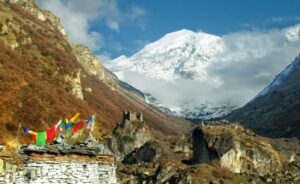The ultimate trek in Bhutan and one of the greatest treks in the world. Three full weeks of highly challenging hiking, crossing some of the mightiest passes in these great mountains, in the wildest, most remote part of the legendary kingdom. The route leads into a hidden region of stupendous beauty, utterly removed from the outside world. The trail winds through dreamlike vistas directly below the massive snow and ice barrier of the Himalayas along the Tibetan border. Majestic peaks, crystalline waterfalls, turquoise alpine lakes, roaring glacial rivers, endless fields of exquisite mountain flowers, and encounters with rare animals and birds become the trekker’s world. The people we meet along the way still live according to ancient, centuries-old patterns, following a way of life as it existed before the industrial age changed the face of the earth forever.
DAY 01: ARRIVE PARO
Flying in to the country’s only airport, in the beautiful Paro valley, the clear mountain air, forested ridges, imposing monasteries and welcoming Bhutanese people in their striking national dress, provides a breath-taking first impression.
Your guide who is going to be with you throughout your trip from our company will meet you at the airport. A fifteen minute drive follows the narrow winding road to our hotel which is a traditional Bhutanese building with attractive gardens and an exceptionally peaceful atmosphere. In the afternoon, we will visit the Ta-Dzong which was built in 1651 as a watch tower for the Rinpung Dzong. Since 1967, the watch tower has served as the home of the National Museum and holds a fascinating collection of art, ancient relics and religious artifacts. Next in line is Rinpung Dzong built in 1646 by Shabdrung, the first spiritual and temporal ruler of Bhutan, the Dzong houses the monastic body of Paro and its district administration. If there is time, we will walk along the small main street of Paro in the evening with its typically Bhutanese shops and small lodges. Altitude at Paro – 2250 meters.
Overnight: Hotel in Paro
DAY O2: TAKTSANG EXCURSION
Today as the part of acclimatization trip, we will hike up to the famous 17th century temple called Taktsang or the Tigers nest perched on a rock face 900 meters above Paro valley. In 8th century, Guru Rinpoche; the great Indian saint who brought Buddhism to Bhutan, is believed to have arrived here flying on the back of a tigress and have meditated here for about three months. It is revered as one of the most sacred places, every Bhutanese wish to visit this place at least once in their lifetime. To get there, it takes about two hours of uphill walk. The trail to the monastery climbs through beautiful pine forest, many of the trees festooned with Spanish moss, and an occasional grove of fluttering prayer flags. We will have lunch at the cafeteria on our way back from the monastery, and then continue our hike down to the bottom.
Overnight: Hotel in Paro
DAY 03: DRUKGYEL DZONG-SHANA (4-5 hours)
Drive up to Drukgyel Dzong (2,580m) where the road ends and the trek begin. With a gradual climb the trail follows the Pachu (Paro river) passing beautiful meadows, paddy fields and impressive farm houses. After about four hours you will reach the army post at Gunitsawa village. At the army check point your trek permit (provided by your tour operator) will be checked and endorsed. The campsite is on the opposite side of the river, not far from Gunitsawa.
Overnight: Tented Camp – Shana (2850m)
DAY 04: SHANA-THANGTHANGKA (7-8 hours)
On this long day, the trail continues with lots of small ups and downs. After going uphill through the river valley, you enter the Jigme Dorji National Park. The valley finally narrows gradually to a mere path which ascends to a meadow where a camp will be set up. From here, if weather permits, you will have the first great view of Mount Jhomolhari.
Overnight: Tented Camp – Thangthangka (3610m)
DAY 05: THANGTHANGKA-BASE CAMP (4-5 hours)
If you did not see Mount Jhomolhari last evening, you will have a great chance to get a great view this early morning. This morning, the trek continues up the Pachu valley which widens into patches of alpine meadow and meager growths of forest. Cross an army outpost along the way and enjoy a spectacular view of high mountain ridges and snow-capped peaks. Yaks and the herder’s homes become a regular feature of the landscape. Passing the villages Soe, Takethang and Dangochang is another asset on this day. Reaching Jangothang, one of the most beautiful campsites of the Himalayas, you will again have a spectacular view of Mount Jhomolhari.
Overnight: Tented Camp – Base Camp (4080m)
DAY 06: HALT AT BASE CAMP
The day in Jangothang provides plenty of possibilities for day hikes with great views on lakes and snow capped mountains such as Jhomolhari and Jichu Drake. There are good chances to spot some blue sheep on the upper slopes of the valley. Jangothang is a perfect environment for your acclimatization. Trek up to Tsophu or hike around the area. There are good short hiking trails in three directions. Jhomolhari and its subsidiary mountain chains lay directly west, Jichu Drake to the north and a number of unclimbed peaks to the east.
DAY 07: BASE CAMP-LINGSHI (6-7 hours)
After 15 min. from the camp the trail climbs rapidly for about half an hour and then becomes a gradual ascend to the Nyilila pass at 4,870m. While on the climb enjoy the surrounding. You might see herds of blue sheep grazing on the slopes of the mountains. From the pass you will have spectacular views of Mt. Jhomolhari, Jichu Drake and Tsherimgang, all of them rising above 7,000m. On the way down to the camp you will pass by some of the yak herder’s tent, made from yak wool, where the herders take shelter while on the move to various pastures for their yaks. As you come down into the Lingshi basin, you get a wonderful view of Lingshi Dzong on a clear day. Tserimgang and its glaciers rise up at the north end of the valley. The campsite is next to a stone hut you reach just before Lingshi Dzong.
Overnight: Tented Camp – Lingshi (4010m)
DAY 08: LINGSHI – CHEBISA (5-6 hours)
Cross the stream below the camp on a wooden bridge and climb up the opposite side to a Chorten just below Lingshi Dzong. In the valley to the east is a cluster of wood shingled houses which is one part of Lingshi village. If you look back at Tsering Kang you can see a very distinct rock pinnacle sticking up at the end of the East Ridge. The climb is gradual and easy. The camp site is on a meadow just opposite the Chebisa village (3880 m).
Overnight: Tented Camp – Chebisa (3880m)
DAY 09: CHEBISA – SHOMUTHANG (6-7 hours)
This morning, we have a big uphill climb along the vast meadow till Gobula pass (4440m). As we climb up slowly, we may see some blue sheep grazing in high yak pastures and some vultures flying high and handsome in the clear blue sky. After the Gobula pass, it’s mostly downhill to our camp beside a stream through the forests of junipers and firs.
Overnight: Tented Camp – Shomuthang (4260m)
DAY 10: SHOMUTHANG – ROBLUTHANG (6-7 hours)
We have a short steep climb and then the trail is level before it gradually starts to climb up the valley crossing the stream for a few times. On this stretch of our trek, we can see lots of edelweiss flowers and we can also have the view of snowcapped peak to the south-east called Khang Bum (6526 m). Once we are at Jhari La (4747 m), the trail goes steep down for about two hours through dwarf rhododendrons, junipers and firs till the campsite. If you are here in the summertime, there will be hundreds of takins to be seen grazing on the slopes of the nearby hills for this valley is a chosen summer home.
Overnight: Tented Camp – Robluthang (4160m)
DAY 11: ROBLUTHANG-LIMITHANG (6-7 hours)
Today we have a long, hard day, crossing Sinchu La, the last and the highest pass on the trek. It’s a tough climb from here to the pass because the high altitude will slow you down considerably. Passing a false summit with a cairn, the trail levels out a little before reaching some rock cairns and prayer flags on Sinchu La (5005m). The snow covered peak of Gangchentag fills the horizon to the north.
The descent is on a rough, rocky trail that follows a moraine into another glacial valley. It’s then a short walk on a good trail through a cedar forest interspersed with small meadows to Limithang (4140m), a lovely camp site in a big meadow by the river. The peak of Gangchentag towers over the campsite, even though it’s quite a distance away.
Overnight: Tented Camp – Lingmithang (4140m)
DAY 12: LIMITHANG-LAYA (4-5 hours)
Today its mostly downhill along a winding river, the trail splits, one going down with the river to the camp site used by the army. The other stays high and takes you into the West Side of Laya Village. We will camp on a high flat bench above the East End of the Laya village (3800m).
Overnight: Tented Camp – Laya (3800m)
DAY 13: REST DAY AT LAYA
If you have trekked from Drukgyel Dzong you should spend a day recuperating from the trek to Laya and preparing yourself for the rest of this hard but spectacular trek. If you have started from Tashitang/Damji (Punakha) you should also walk up to Laya to acclimatise and not just stay at the trail junction to Lunana. However, only for the great views from Laya and its extroadinary inhabitants it’s worthwhile to spend one day in Laya.
DAY 14: LAYA- RHODUPHU (7-8 hours)
From Laya we descend to an army camp and continue following the river till the turn off point to Rhoduphu. After lunch the climb continues through rhododendron bushes till you reach the camp at Roduphu just next to the Rhodu Chhu.
Overnight: Tented Camp- Rhoduphu (4160m)
DAY 15: RHODUPHU-NARETHANG (5-6 hours)
After following the river for about half an hour you will have a steady climb to a high open valley at 4,600m and then further up to Tsomo La (4,900m). Tsomo La offers a superb view of Lunana, Mount Jomolhari and Jichu Drake, and the Tibetan border. The route then crosses a flat, barren plateau at about 5,000m. The campsite at Narethang is towered by the peak of Gangla Karchung (6,395m).
Overnight: Tented Camp – Narethang (4900m)
DAY 16: NARETHANG-TARINA (6-7 hours)
From the camp you will climb for about an hour to Gangla Karchung La (5,120m). The view from the pass is breathtaking and the whole range of mountains including Jekangphu Gang (7,100m), Tsenda Kang and Teri Gang (7,300m) can be seen. The pass descends along a large moraine. Again one has great views: a massive glacier descends from Teri Kang to a deep turquoise lake at its foot. Up here a glacial lake burst through its dam in the early 1960s, causing widespread damage and partially destroying Punakha Dzong. Finally, it is a very long descent through thick rhododendron to Tarina valley, where you will find several good campsites along the Tang Chhu.
Overnight: Tented Camp – Tarina (3970m)
DAY 17: TARINA-WOCHE (6-7 hours)
The walk leads down through conifer forests following the upper ridges of the Pho Chhu, passing some impressive waterfalls. The trail then climbs over a ridge and drops to Woche, a settlement of a few houses, the first village in the Lunana region.
Overnight: Tented Camp – Woche (3910m)
DAY 18: WOCHE-LHEDI (6-7 hours)
The trek starts through juniper and fir forests, and further ahead, through rhododendron bushes. Climb up to Keche La pass (4,650m) where one can have the great view of surrounding mountains again. After the pass, descend to the riverside walking through a village with a stunning view of Table Mountain and others. Follow up the river till Lhedi Village. Lhedi has a basic health unit, a school and a wireless telephone connection.
Overnight Camp – Lhedi (3700m)
DAY 19: LHEDI-THANZA (6-7 hours)
In clear weather, you will have great views of Table Mountain (7,100m).Around lunchtime you will pass the small village of Chozo (4,090m) which has a dzong still in use. Reaching Thanza again you will have a great view of Table Mountain which forms a 3,000m high wall of snow and ice behind the village. Although there are possibilities to camp directly at Thanza, most groups prefer to camp in Thoencha.
Overnight: Tented Camp – Thanza (4150m)
DAY 20: REST DAY AT THANZA
In Thanza walk around and experience some village life or climb up the ridge for fascinating views of lakes and mountains. But as it takes time to arrange new yaks (the yaks from Laya will not go further than Thanza) you might have to spend one day at Thanza anyway.
DAY 21: THANZA-DANJI (3-4 hours)
From Thoencha, the trail climbs up to a large boulder from where you will have excellent views of Thanza, Toencha and Choso village and the surrounding mountains. After a few hours of relatively flat and easy walking, you will reach a yak meadow with some yak herders’ huts. An excellent campsite with a great chance to spot some blue sheep is on the hills above. A trail junction near the campsite will give you the choice between the route further on to Bumthang or to Sephu (Trongsa).
Overnight: Tented Camp – Danji (4230m)
DAY 22: DANJI-TSOCHENA (5-6 hours)
Having chosen the route to Sephu, the trek crosses the creek and after a long climb, you will reach Jaze La (5,150m) with spectacular panoramic mountain views. The path then descends between snow covered peaks and a couple of small lakes to the campsite near the Shore of Tshochena Lake.
Overnight: Tented Camp – Tsochena (4970m)
DAY 23: TSOCHENA-JICHU DRAMO (5-6 hours)
You follow the bank of the blue green lake before arriving at a ridge at 5,100m, where there is another spectacular view in all directions. After going up and down over small hills to reach a glacial lake, the route descends first before climbing again up the next pass, the Loju La (5,140m). Finally after crossing a small saddle (5,100m) you will enter a wide glacial valley from where the trail descends gradually to the campsite at Jichu Dramo.
Overnight: Tented Camp – Jichu Dramo (5050m)
DAY 24: JICHU DRAMO-CHUKARPO (5-6 hours)
Right after leaving the camp you will climb through a moraine to Rinchen Zoe La (5,320m). A spectacular mountain scenery with Gangkhar Puensum amongst the impressive mountains is the reward for climbing the highest pass on this trek route. Rinchen Zoe Peak (5,650) towers above the pass the west. Descending from the pass, the route leads into a wide valley with several lakes and goes steeply down along a moraine to the Thamphe Chhu. Here the vegetation begins to thicken again and you will see the first real trees since Lhedi. After a couple of hours you reach the campsite at Chukarpo.
Overnight: Tented Camp – Chukarpo (4600m)
DAY 25: CHUKARPO-TAMPE TSO (5-6 hours)
The descent continues along the river till you reach the yak herder huts at Gala Pang Chhu (4010m). From here the trail climbs steeply towards Tampe Tsho, a beautiful clear turquoise lake, with the campsite next to it.
Overnight: Tented Camp – Tampe Tso (4300m)
DAY 26: TAMPE TSO-MAUROTHANG (4-5 hours)
From the lake you climb steeply to the last pass on your trek, the Thampe La (4,600m) with a good chance to spot some blue sheep on the way. Then the path descends to the sacred lake Om Thso. Passing a waterfall you will reach another, smaller lake 100m below to descend steeply to the Nikka Chhu. The path finally leads through mixed forest to large clearing on the banks of the river with a few yak herder huts, Maurothang.
Overnight: Tented Camp – Maurothang (3610m)
DAY 27: MAUROTHANG-SEPHU (5-6 hours)
On the last day of this extraordinary trek you will have to change from yaks to horses as the yaks will not be willing to go further down. The path follows the Nikka Chhu to reach a large grassy area overlooking the road and the village of Sephu. You finally reach the road at the Nikka Chhu Bridge at Sephu where you will find several stores (mainly selling bamboo products) and small restaurants. This is where our vehicle will be waiting for us to take a drive of about an hour to Phobjikha valley across Pele La pass to sleep eventually in nice rooms with hot showers.
Overnight: Hotel in Phobjikha
DAY 28: PHOBJIKHA-THIMPHU
This morning, we will proceed to Thimphu. Enroute visit to the famous Punakha Dzong of 17th century, and as we get to Dochu La (pass) we will be able to see most of the mountains that we got so close while on trek.
Overnight: Hotel in Thimphu
DAY 29: THIMPHU-PARO
Day at leisure in Thimphu and then take a drive to Paro towards the evening for your last night stay in Bhutan. We will have a farewell dinner tonight.
Overnight: Hotel in Paro
DAY 30: DEPARTURE
After breakfast in the hotel, drive to the airport in time to catch up your onward flight. Your escort from our company will bid you farewell and soon the remote and legendary Dragon Kingdom disappears again behind its guardian mountains.




